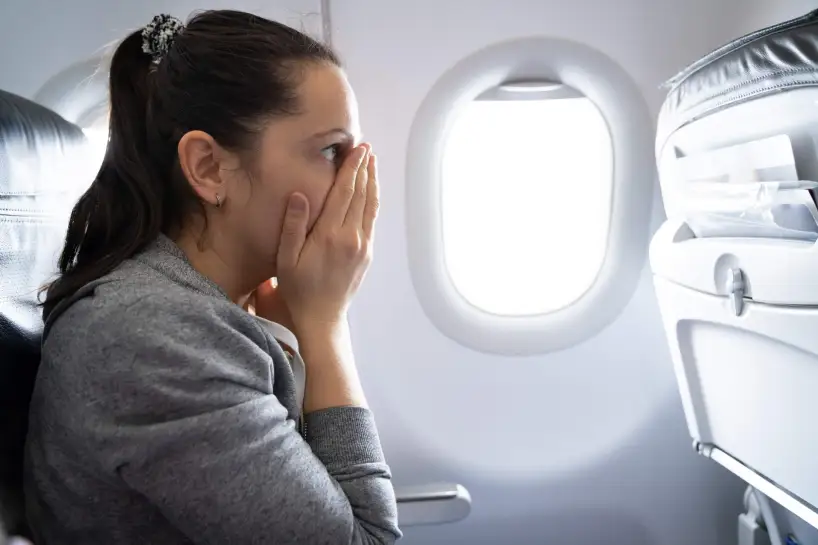The fear that you’ll lose control, cause an accident, or panic while driving can have severe effects. Learn about why some people have a fear of driving and what helps improve the problem.
Fear of Driving
Driving is a daily activity for many people in most of the United States. So, if you are suffering from a fear of driving, also known as vehophobia, it can limit your everyday life significantly. A driving phobia can make you unable to attend school or work, get the medical care or groceries you need, and become isolated from friends and family – all because of the fear that driving provokes.
Fortunately, a driving phobia isn’t something you just have to live with – treatment is available and can lead to relief! This article will discuss what a driving phobia is, what can cause it, describe how it can be treated, and answer some common questions about the condition.
What is Driving Phobia (vehophobia)?
Vehophobia is a specific phobia that relates to a persistent and intense fear of driving a vehicle. Specific phobia is a term for any instance in which you experience notable fear or anxiety about something specific, and where the intensity of your fear or anxiety is out of proportion to the real risks that may be present. In other words, these aren’t just everyday fears – they are persistent fears so powerful that they negatively impact and disrupt your quality of life.
If you have a phobia, you’ll likely try to avoid the situation you fear altogether, or you will have to put up with intense fear and emotional upset every time you’re in that situation. Some common types of phobias include:
- animal phobias (e.g., dogs, snakes, bees)
- natural environment (e.g., thunderstorms, heights)
- blood-injection-injury (e.g., needles, wounds)
- situational phobias (e.g., elevators, airplanes)
Driving phobia is a type of situational phobia. About 8-12% of adults in the United States suffer from a phobia in a given year, and phobia symptoms usually continue if left untreated. So, whether your phobia symptoms are mild or severe, it’s important to get help from a mental health professional.
Symptoms of Driving Phobia
With driving phobia as with any specific phobia, it’s common to experience physiological sensations connected with increased fear and anxiety. These sensations are part of the fight-or-flight response, which is the body’s natural reaction to situations that seem threatening. It’s also common to experience various anxious thoughts or worries about the dangers of driving.
Some common sensations include:
- Sweating
- Trembling
- Rapid, shallow breathing
- Shortness of breath
- Chest pain or tightness
- Increased heart rate
- Feeling dizzy or lightheaded
- Nausea or abdominal discomfort
- Tingling or numbness
Some common worries about the dangers of driving are:
- Being in a severe accident or dying
- Driving too fast and losing control of the car
- Being trapped inside a car
- Causing an accident and injuring others
- Being stranded on the side of the road
- Having a panic attack while driving
The fear and anxiety associated with driving phobia aren’t limited to when you’re in the car. They also include worrying about needing to drive in the future, or experiencing increased physical sensations of anxiety when thinking about driving, or even hearing someone talk about driving.
What Causes Driving Phobia?
There isn’t always an obvious cause or explanation for why you might develop a driving phobia. However, there are some experiences that often contribute to this phobia, including:
- Being in a car accident
- Witnessing a car accident or someone you’re close to being in a car accident
- Experiencing panic attacks or extreme levels of fear while driving
- Driving in risky conditions, such as in an intense rainstorm or snowstorm
- Spending time around people who were fearful of driving or discussed a fearful attitude toward driving during your youth
- Reading about or seeing news coverage about car accidents
Driving and PTSD
Being afraid of driving isn’t always part of a driving phobia, however. Sometimes it can be due to posttraumatic stress disorder (PTSD). This condition can arise after experiencing a traumatic event while driving or riding in a motor vehicle. For example, you might be in or witness a severe accident, suffer a medical emergency while driving (e.g., a heart attack), or be a victim of a car-related crime (e.g., carjacking).
In PTSD, various things associated with the traumatic experience can trigger intense emotional and physical reactions of fear, anxiety, and panic. These triggers are so uncomfortable that people who experience them tend to avoid the activities, situations, and locations that can bring them on. So, if you have PTSD related to driving, you might avoid certain situations locations (e.g., where the traumatizing incident took place), or driving altogether. Intrusive thoughts, nightmares, and flashbacks related to the traumatic event are also part of PTSD for some people. Thankfully, there are effective treatments for PTSD, including when it develops after traumas related to driving.
Fear of Driving and OCD
Another reason you might have a fear of driving is due to obsessive-compulsive disorder (OCD). In OCD, obsessions about possibly having run over someone while driving and not recalling it (also known as hit-and-run OCD) are common, and can lead to compulsions like constantly scanning the rearview mirror, or circling back on your route to look for confirmation that you didn’t hit someone. In this case, it’s the agonizing doubt about whether or not something bad happened that leads to anxiety and fear, more than elements of driving itself (e.g., high speed roads, getting into an accident). Thankfully, hit-and-run OCD is also a treatable condition.
How to Get Over the Fear of Driving on Freeways, Highways, Bridges, and in Tunnels
Freeways, highways, bridges, and tunnels are some of the most feared situations for individuals with driving phobia. That said, a fear of driving can either be general (i.e., a fear of anything having to do with driving), or can be limited to one or more of these particular situations. Regardless of the details of your driving phobia, the treatments described below are proven to help.

Treatment for Driving Anxiety
Cognitive behavioral therapy (CBT) is a highly effective psychological treatment for driving phobia, just as it is for other specific phobias.
Exposure therapy is one particular CBT intervention that is very effective in treating driving phobia. Exposure therapy treats anxiety by helping you approach rather than avoid the things that cause anxiety and fear, so you can learn to withstand them. You and your therapist work as a team to gradually expose you to situations that you fear. Over time, these exercises (called exposures), reduce anxiety and fear and help you overcome your phobia.
Some CBT providers use virtual reality (VR) to carry out exposure therapy. This can be helpful if your anxiety levels when actually getting behind the wheel are so high you can’t bring yourself to do it at all, or you don’t have reliable access to a car to practice real life driving exposures. VR can therefore be helpful as a preliminary step in exposure before moving on to driving an actual car, or as a stand-in when a vehicle isn’t available. However, though helpful, VR is not a necessary part of therapy for a driving phobia.
As mentioned above, phobias, including driving phobia, tend to persist unless you do something to address them. So, seeking mental health treatment for your phobia can be important for improving your quality of life and reducing suffering.
What to Do If You Have a Panic Attack While Driving
Having a panic attack, or experiencing very high levels of anxiety and fear when driving can be scary and upsetting. It’s a common fear among people with driving phobia. Following the steps below can help you navigate your fear in this distressing situation:
- Acknowledge to yourself what’s really going on: you’re having a panic attack. Panic attacks are very uncomfortable and can feel dangerous, but are actually harmless and temporary. This is because they come from your body’s natural reaction to sensing danger, whether or not danger is actually present.
- Use paced breathing. Panicking makes you breathe more quickly, so try to slow your breathing rate and take deeper breaths, using your diaphragm, and keep at it. Breathing this way can help counteract the fight-or-flight response and calm you down.
- Keep driving and wait for the panic attack to go away. If you truly feel you can’t keep driving until it’s gone, drive to the nearest place you can safely pull off the road. Once you are safely stopped, use paced breathing as described above and wait for the intensity of the anxiety symptoms to pass. When your anxiety level is a bit lower and you’re feeling calmer, resume your travel.
There are also things you can do after driving and before driving again if you’ve experienced a panic attack while driving. The most important of these is to seek mental health treatment to help you overcome panic attacks and/or driving phobia.

Frequently Asked Questions about the Fear of Driving:
Should I drive if I have anxiety?
The answer to this question may surprise you: yes, generally you should not give up driving due to anxiety. CBT and exposure therapy help you confront your fear as part of treatment, which typically means spending time driving. This is because although avoidance is an understandable reaction to situations that are frightening or scary, it helps lower anxiety and fear only in the short term. Unfortunately, avoidance worsens anxiety and fear in the long term.
What is the difference between vehophobia and amaxophobia?
Vehophobia is the fear of driving a vehicle. Amaxophobia is the fear of being in a vehicle, whether as a passenger or a driver. So, while similar, the two phobias are distinct, though you may find these terms are used interchangeably, or referred to simply as driving phobia.
Is it normal to be scared to drive?
Driving is a common activity for many people. As with any common activity, there can be people who are fearful of it. For example, many new drivers feel anxious about driving until they accumulate enough experience to feel more capable. However, many people do not experience significant fear of driving. Driving phobia is a pathological level of fear related to driving. What matters most is if you are limited by the fear you feel – if so, you may have a driving phobia. With treatment, it is possible to overcome fear associated with driving, so it doesn’t hold you back in your daily life.
How common is amaxophobia?
It’s hard to assess exactly how many people suffer from a driving phobia. As mentioned above, about 8-12% of adults in the United States suffer from a specific phobia in a given year. Driving phobias are particularly common after being in a motor vehicle accident, as around one-third of accident survivors develop PTSD, which is likely to involve fear and avoidance of driving and motor vehicles.
What is the best therapy for fear of driving?
The best therapy for fear of driving is cognitive behavioral therapy (CBT). Whether your fear of driving stems from a phobia, PTSD, or panic disorder, CBT is proven to help each of these conditions. CBT for these conditions almost always includes exposure therapy. This treatment helps you learn to approach, rather than avoid, the situations that cause you fear. You and your clinician work together to devise a plan to accomplish this through repeated practice exercises that reduce your fear and avoidance and lead to relief.
Conclusion
Because driving is a part of everyday life for so many of us, a fear of driving can cause a lot of distress and negative impact to your day-to-day life. However, an important take away is that a fear of driving doesn’t have to run your life. Effective treatment is available, which can lead to improved quality of life and relief. Reach out to a mental health professional if you experience fear of driving.









